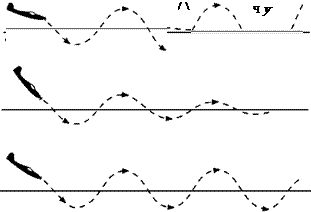Stability and control
Meaning of stability and control
The stability of an aeroplane means its ability to return to some particular condition of flight (after having been slightly disturbed from that condition) without any efforts on the part of the pilot. An aeroplane may be stable under some conditions of flight and unstable under other conditions. For instance, an aeroplane which is stable during straight and level flight may be unstable when inverted, and vice versa. If an aeroplane were stable during a nose-dive, it would mean that it would resist efforts on the part of the pilot to extricate it from the nose-dive. The stability is sometimes called inherent stability. Note that, nowadays, some military combat aircraft are deliberately made to be inherently unstable, as this increases their manoeuvrability, and can reduce drag. This requires a sophisticated automatic artificial stabilisation system, which has to be totally reliable. Because of the potentially disastrous consequences of system failure, inherent instability is not permitted on civil aircraft, but with adequate safeguard it is possible to relax the level of stability compared to older types, and this has benefits in terms of reduced drag. To the pilot, the artificial stabilisation system makes the aircraft feel and handle as though it were stable.
Stability is often confused with the balance or ‘trim’ of an aircraft, and the student should be careful to distinguish between the two. An aeroplane which flies with one wing lower than the other may often, when disturbed from this attitude, return to it. Such an aeroplane is out of its proper trim, but it is not unstable.
There is a half-way condition between stability and instability, for, as already stated, an aeroplane which, when disturbed, tends to return to its original position is said to be stable; if, on the other hand, it tends to move farther away from the original position, it is unstable. But it may tend to do neither of these and prefer to remain in its new position. This is called neutral stability, and is sometimes a very desirable feature.
Figure 9.1 illustrates some of the ways in which an aeroplane may behave when it is left to itself. Only a pitching motion is shown; exactly the same considerations apply to roll and yaw, although a particular aeroplane may have quite different stability characteristics about its three axes. The top diagram shows complete dead-beat stability which is very rarely achieved in practice. The second is the usual type of stability, that is to say an oscillation which is gradually damped out. The steady oscillation shown next is really a form of neutral stability, while the bottom diagram shows the kind of thing which may easily occur in certain types of aircraft, an oscillation which steadily grows worse. Even this is not so bad as the case when an aeroplane makes no attempt to return but simply departs farther and farther away from its original path. That is complete instability.
The degree of stability may differ according to what are called the stick – fixed and stick-free conditions; in pitching, for instance, stick-fixed means that the elevators are held in their neutral position relative to the tail plane, whereas stick-free means that the pilot releases the control column and allows the elevators to take up their own positions.
Another factor affecting stability is whether it is considered – and tested – under the condition of power-off or power-on. On modern aircraft the engine thrust can be comparable with or even greater than the airframe weight and therefore may significantly influence the stability.
 |
4
Control means the power of the pilot to manoeuvre the aeroplane into any desired position. It is not by any means the same thing as stability; in fact, the two characteristics may directly oppose each other.
The stability or control of an aeroplane in so far as it concerns pitching about the lateral axis is called longitudinal stability or control respectively.
Stability or control which concerns rolling about the longitudinal axis is called lateral stability or control.
Stability or control which concerns yawing about the normal axis is called directional stability or control.
Before we attempt to explore this subject any further we feel it is our duty to warn the reader that the problems involved in the consideration of stability and control of aeroplanes are considerable. Any attempt at ‘simple’ explanation of such problems may, at the best, be incomplete and possibly incorrect. Readers need have no fear of the mathematics, as we shall not even attempt to tackle them, but they must be prepared, if and when they acquire greater knowledge of the subject from more advanced works, to readjust their ideas accordingly.
After this very necessary apology we will try to explain, at any rate, the practical considerations which affect stability and control.











